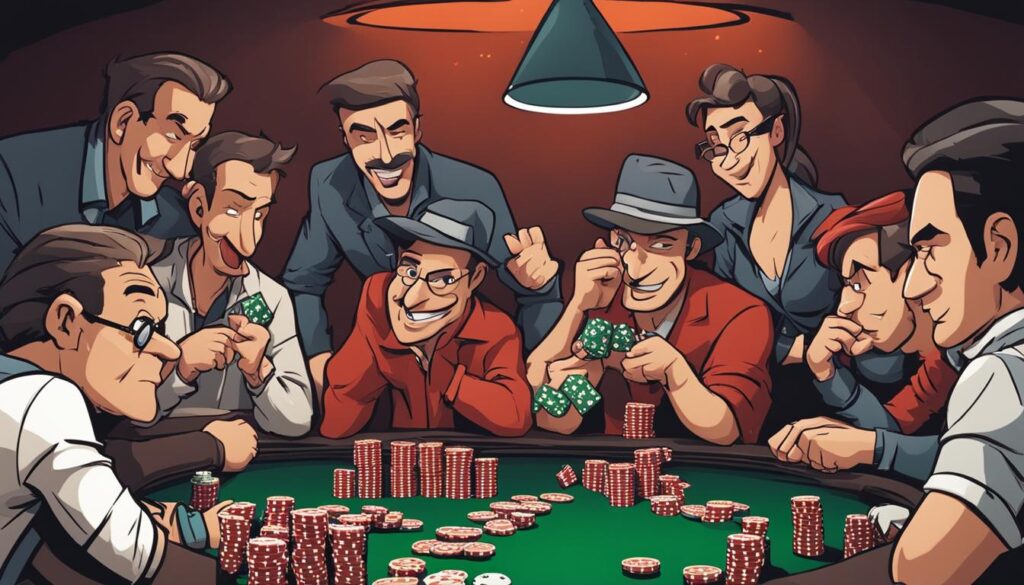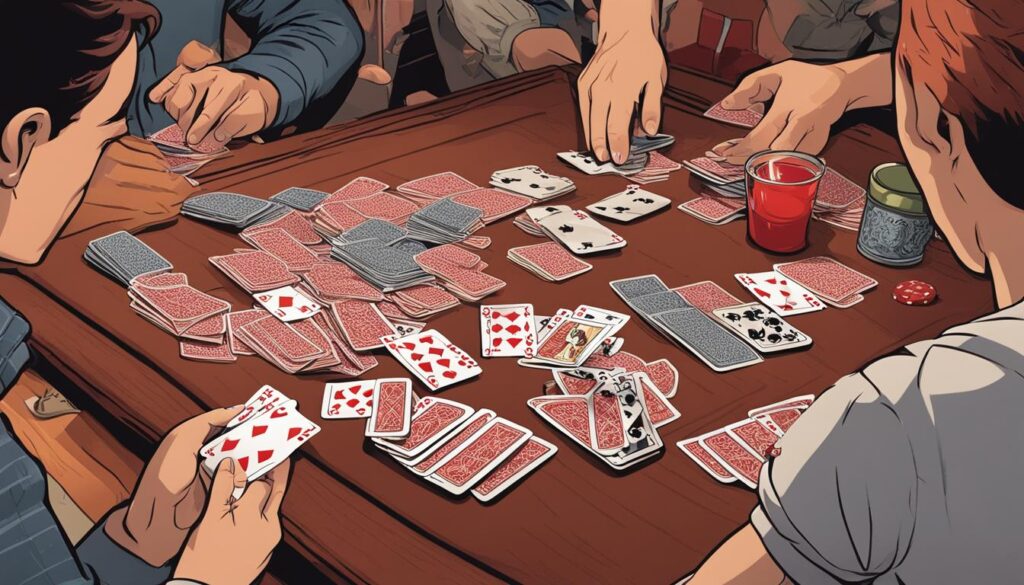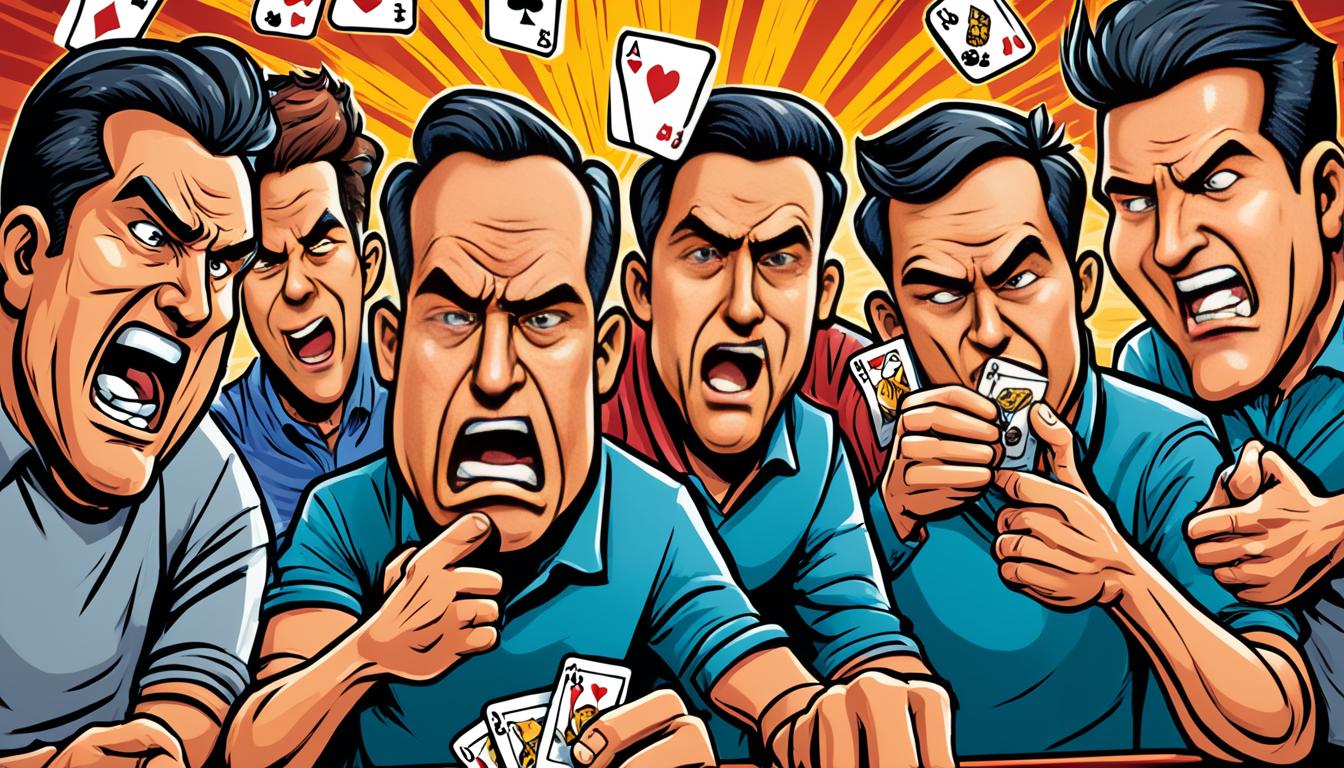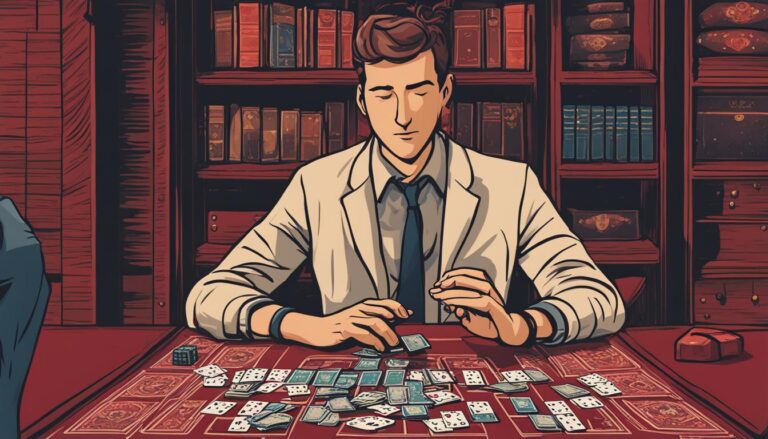Disclosure: This Post Contains Affiliate Links; We earn a commission on purchases.
Welcome to the thrilling world of bluffing in card games! Whether you’re a poker enthusiast or enjoy other card games, mastering the art of bluffing can give you a significant advantage over your opponents. Bluffing involves employing strategic tactics, reading your opponents’ minds, and strategically playing with your own hand.
The art of bluffing, often called the art of deception, is a psychological game that requires careful observation and calculated moves. By understanding poker psychology and developing effective bluffing techniques, you can manipulate the game to your advantage, tricking your opponents into making wrong decisions.
Key Takeaways:
- Bluffing is a crucial technique in card games like poker.
- Successful bluffing involves observing opponents, studying their betting patterns, and detecting their “tells.”
- Timing is crucial when bluffing. Identifying the right moments to bluff can make or break your success.
- Disguising your actions and staying calm after a bluff are important for maintaining your credibility at the table.
- Understanding bluffing fundamentals such as semi-bluffs and bluff equity poker can enhance your strategy.
Table of Contents
The Foundations of Bluffing: Observation and Strategy
The foundation of successful bluffing lies in observing your opponents’ betting patterns, increasing the stakes with a strong hand, and studying their body language for cues that indicate whether they are bluffing or not. By recognizing these patterns and cues, you can make strategic decisions that will enhance your bluffing techniques.
When it comes to bluffing, observing your opponents’ betting patterns is crucial. Pay attention to how they bet in different situations, such as when they have a strong hand versus when they are bluffing. Look for any consistent behavior or patterns that can give away their bluffing tendencies.
Another important aspect of successful bluffing is knowing when to increase the stakes with a strong hand. When you have a winning hand, it’s an opportunity to intimidate your opponents and make them believe you have an even stronger hand. By increasing the stakes, you can force them to fold and win the pot without a showdown.
Studying your opponents’ body language is also a valuable skill in bluffing. Look for any signs of nervousness, hesitation, or excessive confidence that may suggest they are bluffing or holding a weak hand. Pay attention to their eye movements, hand gestures, and posture for potential tells that can inform your bluffing decisions.
“Observe betting patterns, increase stakes with a strong hand, study body language.”
To illustrate the importance of observation and strategy in bluffing, let’s consider a hypothetical poker scenario:
Player A has been closely observing Player B’s betting patterns throughout the game. They have noticed that Player B often makes large bets when they have a weak hand and small bets when they have a strong hand. Armed with this information, Player A decides to bluff on the next hand.
Player A is dealt a mediocre hand, but they know that Player B’s betting pattern indicates weakness. They raise the stakes significantly, making it seem as if they have a strong hand. Player B, believing that Player A has a superior hand, folds, and Player A wins the pot without having to show their cards.
| Bluffing Foundation | Observation and Strategy |
|---|---|
| 1. Observe opponents’ betting patterns | Notice consistent behavior and patterns that reveal bluffing tendencies |
| 2. Increase stakes with a strong hand | Intimidate opponents and force them to fold |
| 3. Study opponents’ body language | Look for signs of nervousness, hesitation, or confidence that indicate bluffing or a weak hand |
When to Bluff: Timing is Everything
Knowing when to bluff is crucial in poker. It’s a delicate balance of reading your opponents, analyzing the board, and choosing the right moment to make your move. In this section, we’ll explore three key bluffing scenarios: bluffing pre-flop, bluffing post-flop, and bluffing on a low paired board.
Bluffing Pre-Flop
Bluffing pre-flop involves making a bold move before any community cards are dealt. This strategy can be effective when your opponents are unlikely to make aggressive moves and may fold to a well-executed bluff. It’s an opportunity to win the blinds, steal the pot without any resistance, and add chips to your stack.
Bluffing Post-Flop
Bluffing post-flop requires careful observation of the community cards and your opponents’ reactions. One favorable scenario for a bluff is when the flop reveals a rainbow of cards with no pairs or high-ranking cards. This makes it less likely that your opponents have strong hands, increasing the chances of a successful bluff. By betting confidently and applying pressure, you can force your opponents to fold and win the pot.
Bluffing on a Low Paired Board
Bluffing on a low paired board involves leveraging the situation where the flop reveals a low pair (for example, two 2s). In this scenario, the remaining cards are likely to be low or unrelated to the pair, making it challenging for your opponents to have a strong hand. By capitalizing on their doubts, you can bluff confidently and potentially take down the pot, even if your hand is weaker than it appears.
Bluffing at the right moment can turn the tables in your favor, even when you don’t have the strongest cards. However, it’s important to remember that bluffing is a high-risk strategy that requires careful consideration of the board, your opponents’ tendencies, and your own table image. Mastering the art of bluffing takes practice, observation, and strategic timing.
Tips for Successful Bluffing
Mastering the art of bluffing in card games requires a combination of skill, strategy, and psychological tactics. To enhance your bluffing techniques and increase your chances of success, consider the following tips:
- Bluffing on small pots: When attempting to bluff, it is advisable to target smaller pots. Bluffing on small pots minimizes potential losses if your bluff is called and allows you to control the size of the pot.
- Bluffing fewer opponents: Bluffing against a smaller number of opponents improves your odds of success. With fewer opponents to consider, there is less likelihood that one of them holds a strong hand.
- Disguising actions: To effectively bluff, it is important to disguise your actions and hide your true intentions. By maintaining a consistent betting pattern and mimicking your behavior when you have a strong hand, you can make it difficult for opponents to read your bluff.
- Assessing opponents’ state of mind: Pay close attention to your opponents’ behavior and demeanor. Assessing their state of mind can provide valuable insights into the strength of their hands. Look for signs of nervousness, hesitation, or overconfidence that may indicate they are bluffing or holding a weak hand.
- Watching for odd betting behavior: Keep a keen eye out for any odd betting behavior exhibited by your opponents. Unusual bet sizing, sudden changes in betting patterns, or excessive betting may indicate weakness or a bluff. Use this information to your advantage when deciding whether to continue with your bluff or fold.
- Staying calm after a successful bluff: It is essential to stay composed and maintain a neutral demeanor after a successful bluff. Getting overly excited or displaying visible signs of triumph can give away your bluffing strategy and make it easier for opponents to detect future bluffs. Stay focused and proceed with caution.
- Being prepared to fold: Even the best bluffers sometimes get called. Be mentally prepared to fold if your bluff is called or if the situation changes. Folding when necessary can save you from unnecessary losses and allow you to regroup for future hands.
By implementing these tips into your bluffing repertoire, you can improve your effectiveness at the poker table and outmaneuver your opponents with skillful deception and calculated risk-taking.

Understanding the Basics of Bluffing
Bluffing is a crucial aspect of poker, and to master this skill, it’s important to understand the fundamentals. Let’s explore some key concepts that will enhance your bluffing strategy.
1. Semi-Bluffs
Semi-bluffs are a powerful technique that involves betting on weak hands with the potential for improvement. By strategically placing bets, you put pressure on your opponents, making them believe you have a stronger hand than you actually do. This forces them to make difficult decisions and can often lead to big wins.
2. Bluff Equity Poker
Bluff equity poker is all about calculating your opponents’ likely reactions to your bets. It involves analyzing their playing styles, tendencies, and the board texture to determine the probability of success for a bluff. This calculation helps you make informed decisions that maximize your bluffing potential.
3. Recognizing Opponents’ Tells
Understanding your opponents’ tells is a crucial skill in bluffing. Tells are subtle physical or verbal cues that reveal information about their hands and decision-making. By carefully observing their body language, changes in betting patterns, or specific statements, you can gain valuable insights that guide your bluffing strategy.
4. Calculating Pot Odds
Calculating pot odds is essential for effective bluffing. It involves assessing the size of the pot and comparing it to the probability of winning with your current hand. This calculation helps you determine whether the risk of bluffing is justified and whether the potential reward outweighs the cost.

By understanding the basics of bluffing, including semi-bluffs, bluff equity poker, opponents’ tells, and calculating pot odds, you’ll be equipped with the knowledge to make strategic bluffing decisions. The next section will dive deeper into identifying and interpreting your opponents’ tells, providing valuable insights for successful bluffing.
Identifying Your Opponents’ Tells
To successfully bluff in poker, it is essential to be able to identify your opponents’ tells. These are subtle cues and behaviors that reveal information about the strength of their hand. By carefully observing their body language, recognizing physical and verbal cues, and analyzing changes in their betting patterns, you can gain valuable insights to enhance your bluffing strategy and increase your odds of success.
Observing opponents’ body language
One of the key ways to identify your opponents’ tells is through their body language. Pay close attention to their eye movements, as shifts in gaze or avoiding eye contact may indicate nervousness or confidence. Observe their posture, as slumping or tensing up can reveal their discomfort or excitement. Notice their breathing patterns, as rapid or shallow breathing could be a sign of anxiety. Additionally, how they handle their chips or cards can provide valuable information, such as fidgeting or hesitating before making a bet.
Recognizing physical and verbal cues
Aside from body language, physical and verbal cues can also offer insights into your opponents’ hands. Listen for changes in their tone of voice, as an increase in pitch or hesitation in their speech may indicate the strength or weakness of their hand. Specific statements or phrases can also reveal valuable information if they unintentionally provide hints about their cards. It’s important to stay attentive and pick up on these subtle cues during gameplay.
Changes in betting patterns
Another vital aspect of identifying your opponents’ tells is to analyze their betting patterns. Pay attention to any deviations or inconsistencies in how they bet during different rounds. For example, sudden increases in bets may suggest a strong hand, while hesitation or smaller bets might indicate a weaker hand or bluff. By studying their betting patterns throughout the game, you can uncover valuable information and adjust your bluffing strategy accordingly.
Being able to identify your opponents’ tells is a skill that takes time and practice to develop. It requires keen observation, careful analysis, and the ability to make quick and accurate judgments. By honing your ability to recognize body language, physical and verbal cues, and changes in betting patterns, you can gain a significant advantage at the poker table and increase your chances of bluffing successfully.
| Common Opponents’ Tells | Interpretation |
|---|---|
| Nervous fidgeting | Potential weak hand or bluff |
| Increased eye contact | Confidence or strong hand |
| Sudden silence or change in tone | Possible strong hand or bluff |
| Quick, shallow breathing | Anxiety or uncertainty |
| Delayed or hesitant betting | Potential weak hand or uncertainty |
| Larger, bold bets | Confidence or strong hand |
Developing Your Bluffing Strategy
When it comes to bluffing in card games, developing a solid strategy is key to increasing your chances of success. By becoming aware of your opponents’ tendencies, choosing the right table, and calculating pot odds, you can strategically play your bluffing hand.
Becoming Aware of Opponents’ Tendencies
To effectively bluff, it is crucial to understand your opponents’ playing styles and tendencies. Pay attention to their bets, actions, and reactions throughout the game. Are they more likely to fold or call? Do they tend to play conservatively or aggressively? By observing and analyzing these patterns, you can adapt your bluffing strategy accordingly.
Choosing the Right Table
Choosing the right table can significantly impact the success of your bluffing strategy. Look for tables with opponents who are less likely to call or raise your bluffs. This can include tables with novice players or those who have a more cautious approach to the game. By strategically selecting your opponents, you increase the likelihood of your bluffs being successful.
Calculating Pot Odds
Calculating pot odds is a fundamental aspect of bluffing in card games. Pot odds refer to the relationship between the potential reward (the size of the pot) and the cost of the bet you need to make. By calculating pot odds, you can determine whether bluffing is worth the risk. If the potential reward outweighs the cost of the bet, bluffing becomes a more favorable option.
“Bluffing requires strategy, observation, and calculation. By becoming aware of your opponents’ tendencies, choosing the right table, and calculating pot odds, you can elevate your bluffing game to the next level.”
| Bluffing Strategy | Benefits |
|---|---|
| Becoming aware of opponents’ tendencies | Allows you to adapt your bluffing strategy |
| Choosing the right table | Increases the likelihood of successful bluffs |
| Calculating pot odds | Helps determine whether bluffing is worth the risk |
By developing a bluffing strategy that incorporates these elements, you can effectively outsmart your opponents and increase your chances of winning.
Calculating Pot Odds: Making Informed Bluffing Decisions
A successful bluff in poker relies on understanding pot odds. Pot odds involve considering the chances of winning with your current hand and evaluating the size of the pot. By calculating pot odds, you can make the informed decision of whether the risk of bluffing is worth taking.
When determining pot odds, you need to assess the likelihood of your hand improving and compare it to the size of the pot. If the potential reward outweighs the risk, bluffing may be a viable option. However, if the pot is relatively small or the chance of success is low, it may be wiser to fold and conserve your chips.
In online poker, where physical tells are not present, calculating pot odds becomes even more crucial. Without the visual cues provided by opponents’ body language, you must rely heavily on statistics and probabilities. Online poker platforms often provide tools and features that assist players in calculating pot odds, such as displaying the size of the pot and the probability of certain hands winning.
By incorporating pot odds into your bluffing strategy, you can make more informed decisions and increase your chances of success. It allows you to weigh the potential risks and rewards, helping you make calculated moves instead of relying solely on intuition.
Example:
Let’s say you have a hand of Ace-King suited in hearts. The flop reveals a 2 of hearts, a 7 of diamonds, and a 9 of clubs. You have a flush draw, meaning you need one more heart to complete your flush. There is $100 in the pot. To make your flush, you have 9 outs (the remaining hearts in the deck).
Based on pot odds, you can calculate your chances of making the flush. With nine outs and 47 unknown cards, the probability of hitting your flush on the next card is approximately 19%. If the size of the pot exceeds the amount you need to call to stay in the hand (e.g., a bet of $20), the pot odds are favorable, making the bluff potentially profitable.
By considering pot odds in this scenario, you can make a more informed decision on whether to continue with the bluff or fold. Understanding pot odds allows you to evaluate the potential value of a bluff and make strategic moves that maximize your chances of winning.
| Pot Size | Required Bet | Pot Odds | Recommended Action |
|---|---|---|---|
| $100 | $20 | 5:1 | Bluff – Favorable pot odds |
| $100 | $50 | 2:1 | Consider Folding – Unfavorable pot odds |
Understanding pot odds is crucial for making informed bluffing decisions in poker. It allows you to evaluate the potential risks and rewards, helping you determine whether to proceed with a bluff or fold. By incorporating pot odds into your strategy, you can increase your chances of success and make more calculated moves at the virtual poker table.
Conclusion
The art of bluffing in poker is a skill that can be mastered through the use of psychological tactics, strategic planning, and keen observation skills. By honing these abilities, players can gain a significant advantage over their opponents and secure victories that may have seemed unattainable. Bluffing requires continuous refinement and adaptation of strategies to keep opponents on their toes and guessing your next move.
Through practice and dedication, anyone can become an expert bluffer. It is essential to study poker strategies and employ psychological tactics to outsmart opponents. By mastering the craft of bluffing, players can elevate their game to new heights and achieve remarkable success at the poker table.
Remember, the art of bluffing is not about luck, but rather a calculated approach. It demands awareness, control, and the ability to read the game and opponents accurately. By understanding the nuances of bluffing and leveraging psychological tactics, you can transcend the boundaries of conventional gameplay and seize victory.
So, embrace the challenge, refine your skills, and become a master of the art of bluffing. With determination and a well-honed poker strategy, you can conquer the tables and leave your opponents awestruck as you claim victory, hand after hand.

As the founder of Friends Game Night, Ryan channels his enthusiasm for gaming into a platform that celebrates the magic of gathering friends around the digital or physical tabletop. Through his website, Ryan shares insightful articles, reviews, and recommendations, aiming to inspire others to create their own memorable gaming moments.
Subscribe to Our Newsletter










